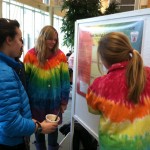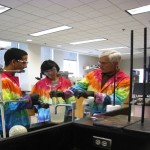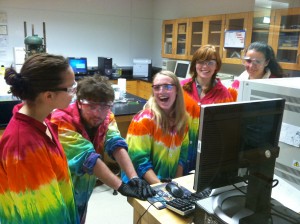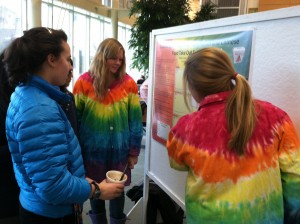
Toxic Posters: The campus community is invited to a poster session in which students present the results from their analytical assessment of exposure to toxic chemicals from consumer products. Photo: Tim Elgren
This past spring, Dr. Tim Elgren, originally the SENCER-ISE Co-PI at Hamilton College, was appointed as the Dean of the College of Arts and Sciences at Oberlin College in Oberlin, OH. Dr. Elgren and his partner at the Green Science Policy Institute (GSP) in Berkeley, CA, Dr. Arlene Blum, saw Dr. Elgren’s new position as an opportunity to expand their existing partnership to include two new colleges.
Last academic year, Drs. Elgren and Blum, along with Ms. Avery Lindeman of GSP, built upon Dr. Elgren’s existing Hamilton College Introduction to Chemistry course into a toxicology lab with elements of civic engagement to provide students with opportunities to share their research with the public.
The partners and SENCER-ISE staff are excited to expand the collaboration to include Hope and Oberlin Colleges.
Dr. Adam Van Wynsbergh, assistant professor of chemistry, is taking on the toxicology curriculum at Hamilton College, with Dr. Greg Rahn, instrumental specialist, contributing to the development and teaching of the labs.
Components of the toxicology lab developed by Hamilton College and GSP will be adapted by Dr. Graham Peaslee, professor of chemistry, to create a similar course at Hope College in Holland, MI.
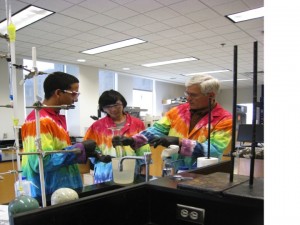
Basic chemistry, such as chemical partitioning, is introduced early in the term to help students design strategies for separating toxins from various materials before quantification is possible. Photo: Karen Brewer
Dr. Elgren will be teaching a version of the course at Oberlin College.
Drs. Blum, Elgren, VanWynsbergh, and Peaslee will also be collaborating to further refine and disseminate the toxicology-focused model for introductory chemistry students and the undergraduate curriculum.
Dr. Ellen Mappen, SENCER-ISE Project Director, knows how important institutional backing is for cross-sector partnerships. Dr. Mappen says, “It is imperative that these collaborations support the partner institutions’ missions and have support of the organizations. If they do not have this, the partnership will not survive a personnel change.” She adds, “We are so happy that the Hamilton College and Green Science Policy Institute’s partnership not only survived Dr. Elgren’s transition to Oberlin College, but has also expanded to include Hope and Oberlin Colleges.”

